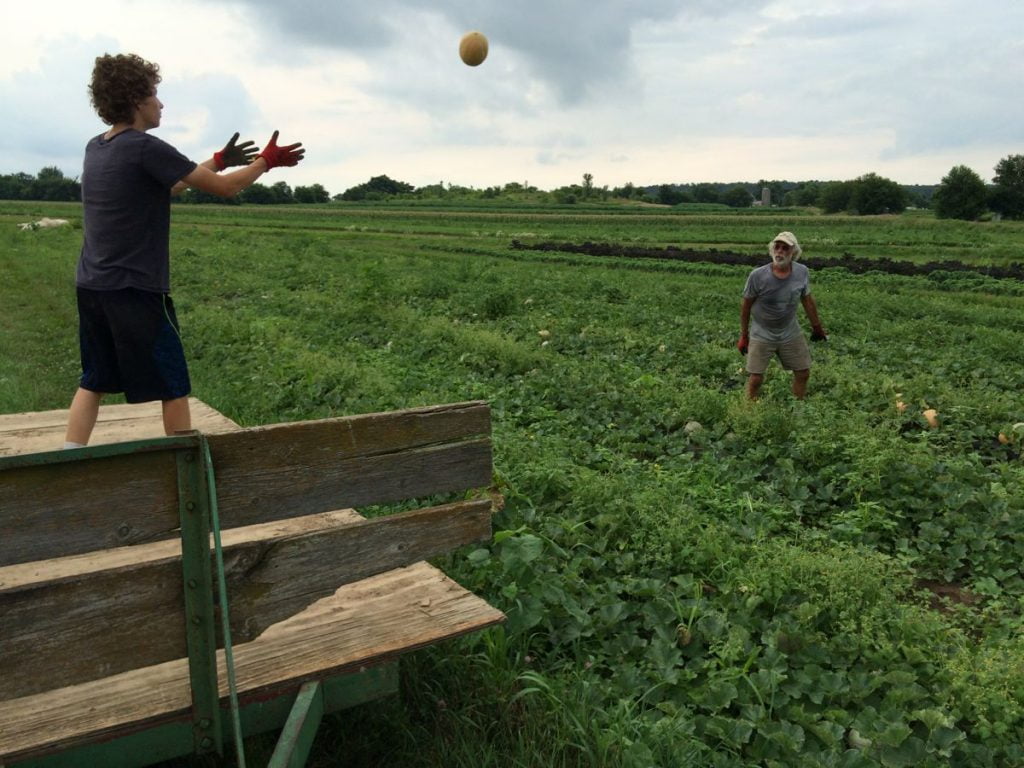Monthly Archives: July 2016
Highlights of the week
- On: July 27, 2016
 0
0
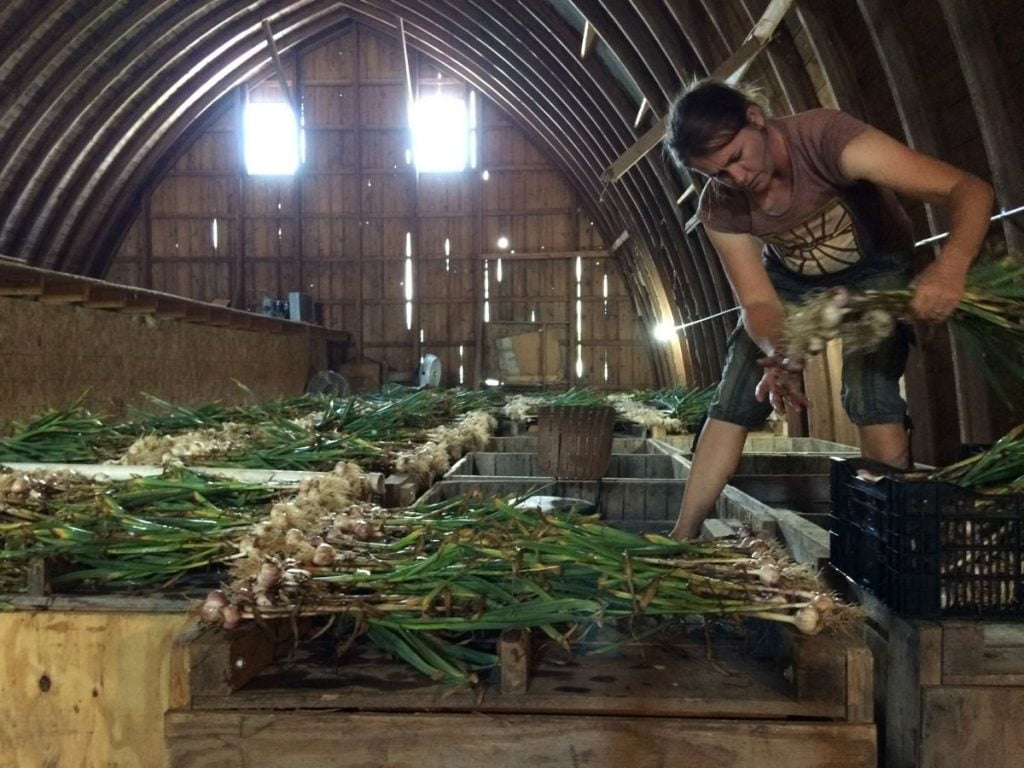
Karen spreads freshly harvested garlic plants.
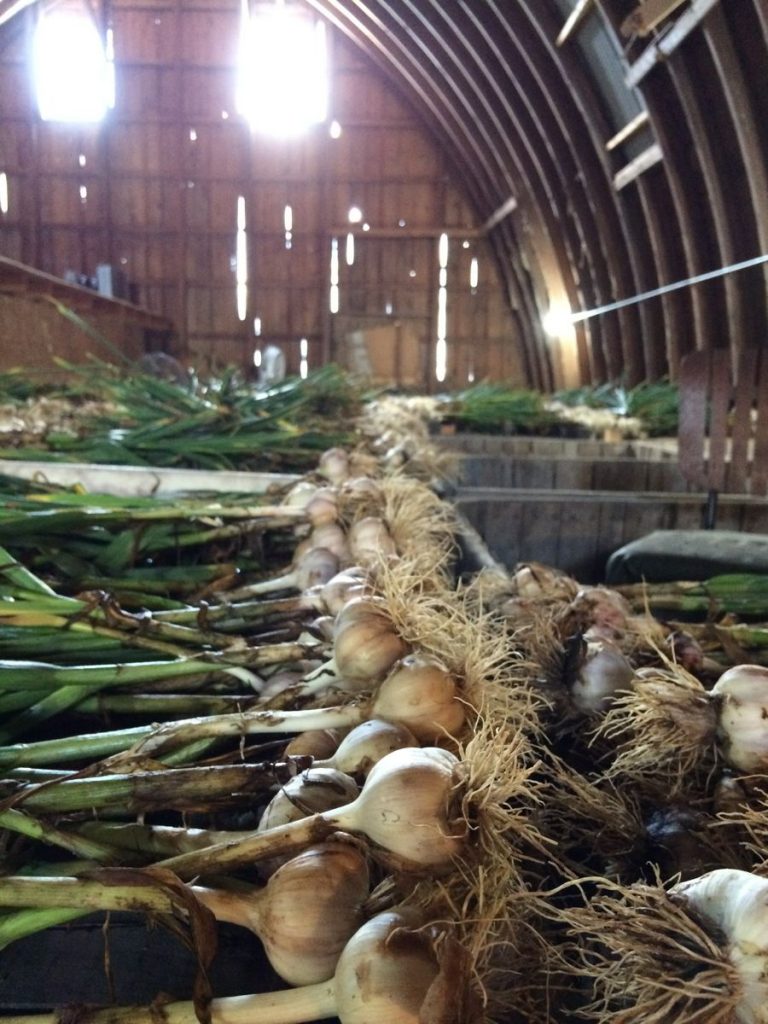
It’s drying nicely in the barn loft.
Garlic harvest was an adventure this past week. This is a “new” crop for us. We’ve always bought most of the garlic for your CSA boxes from our friend John Hendrickson. We will continue to buy everything he can grow for us, but we want to deliver more garlic in the boxes, per your requests. On our annual survey, members consistently ask for more garlic.
This is our biggest garlic crop yet. We’ve dabbled and experimented and increased our seed stock over the past three years. We dug it on Friday and spread it to dry in our barn loft. Look closely at the photos and you’ll see that we spread it on overturned wooden bins, propped on the raised legs of the bins. It’s an easy way to get the garlic up in the air. The barn is dry and warm and the garlic is drying nicely. We will hold some back to plant for next year’s garlic and green garlic crops. The rest will go in the CSA boxes, maybe as soon as next week. You cannot believe how wonderful the barn smells.
Steve and I harvested the first melons over the weekend with help from our son Ari. He has helped with melon harvests for three years but is bigger and stronger this summer, better able to handle heavy watermelons. Outpost and Willy Street coops will stock our watermelons this weekend. We have ripe muskmelons for you this week, and are planning watermelons for the CSA boxes next week.
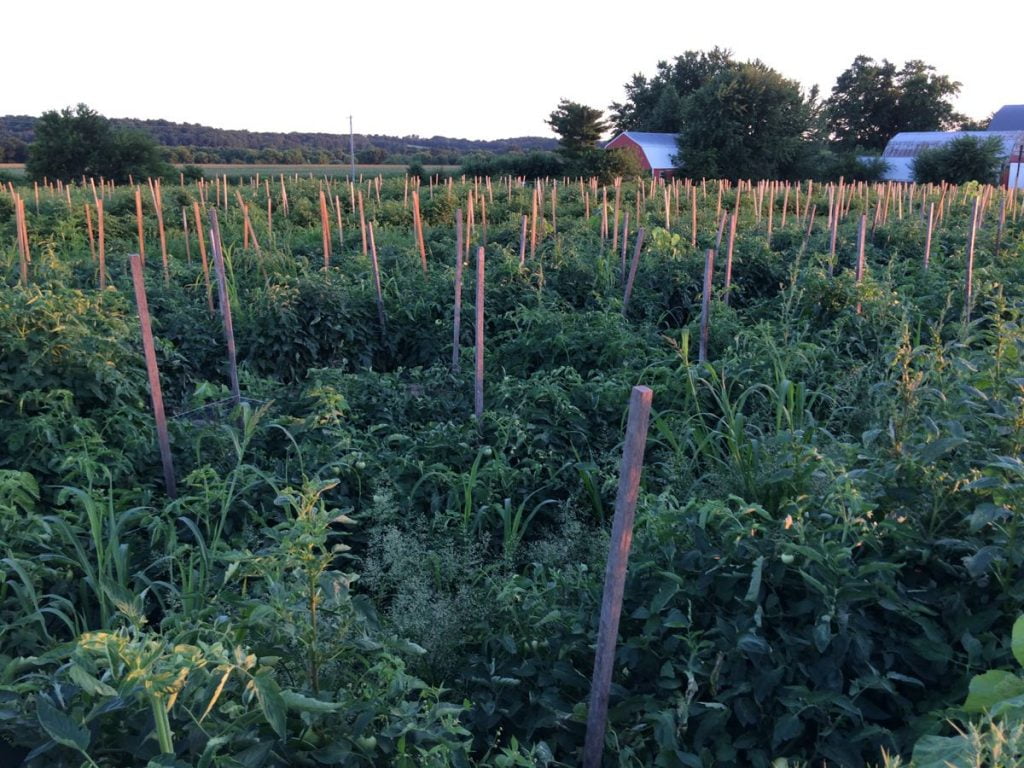
Staked melon field at dusk. It’s a pretty spot on the farm right now. The tomatoes are growing strongly. We’ll have more and more for the CSA boxes in the next few weeks.
Veggie list and veggie notes (July 28/29, 2016, week #11, green EOW)
Sweet corn, about 10 ears
Muskmelon, 1
Snap peas, 0.7 lb
Cherry tomatoes, 1 pint
Tomatoes, 1 or 2
Italian frying peppers, 2 or 3
Cucumbers, about 3
Zucchini & summer squash, 2+ lb
Walla Walla onion, 1 or 2
Dill flowers and ferns, 1 bundle
Each site gets globe eggplant OR Japanese eggplant OR broccoli OR extra cucumber OR an extra corn.
Next week’s box will probably contain melon, tomatoes, peppers, carrots, cucumbers, onions and more.
Sweet corn – Storage. Sweet corn is best when fresh, so we encourage you to eat it asap. Store in the refrigerator, in the husks if you have the room.
Cooking. It is quicker to steam sweet corn than to boil it.
1.) Stand ears of corn upright in a tall pot. Put one inch of water in the pot.
2.) Bring the water to a boil. If the corn is cold when you begin cooking, steam for 5 – 6 minutes. If the corn starts at room temperature, steam for 4 – 5 minutes. The cooking time will vary somewhat depending on how many ears are in the pot. Pay attention to how the corn smells. The scent changes once the corn is ready. Another clue: water will bead on the corn until it is cooked. Don’t overcook it.
Muskmelon – We picked the muskmelons at field-ripe stage. However, Steve says they will be even better if you let them ripen further on your counter for a day or two. Watch for a slight ‘give’ when you press the melon at the blossom end (opposite the stem end). Check for fragrance too. Eat or refrigerate when fully ripe.
Dill flowers and leaves – Your bundle contains both leaves (useful added to many dishes) and flowers (great for pickles). Use whichever part suits you best. A batch of sliced refrigerator pickles would be perfect, seasoned with the dill flowers and buds. Yes, you can pickle sliced ‘normal’ cucumbers. I always choose dill flowers over seed heads when pickling because the flavor is less harsh. Two to four flower umbels per quart of pickles. Pat of Local Thyme has a sweet-sour Refrigerator Dill Pickle recipe with turmeric and mustard. I’ll list our family favorite below.
Refrigerator Pickles
Hang on to this recipe. We should have some pickling cucumbers to share in the CSA boxes, as well as continued slicing cucumbers.
Beth’s notes: We stopped canning pickles years ago because we prefer the flavor and crunch of refrigerator pickles. They will be ready sooner if you slice the cucumbers. You can make refrigerator pickles with ‘normal’ cucumbers (sliced), or with pickling cucumbers (sliced or whole). We often add rings of sweet Walla Walla onions.
Per quart of pickles:
about 1.5 lb pickling cucumbers
optional: sliced red bell pepper strips, without blemishes
1 bay leaf
2 cloves garlic, crushed
2 dill heads (4 if they are small)
1/2 tsp. yellow mustard seed
Brine (enough for 1 quart of pickles)
1 pint water
1.5 Tbsp. pickling salt or table salt
1.5 Tbsp. white vinegar
Mix salt, vinegar and water. Set aside and stir occasionally until the salt dissolves.
Clean the pickles. Place the bay leaf, one garlic clove and one dill head at the bottom of a one-quart jar or container. Pack the jar with pickling cukes (and optional red bell pepper strips), adding the second garlic clove among the pickles. Feel free to slice large pickling cukes into spears to get them to fit compactly. Sprinkle mustard seed over the jar and add the second dill head. Make sure the salt is fully dissolved, then pour brine over the cukes to cover. Pour slowly to allow air bubbles to escape. Cover jar with a lid and refrigerate. Invert the sealed jar every few days to disperse the flavors.
Sliced pickles will be ready in a few days. Whole pickles need at least one week.
RECIPES FROM LAUREN
CHARRED ONION & CUCUMBER SALAD
Adapted from Bon Appetit
Serves 2-4 (but easily doubled!)
Takes 30 minutes
1 green Italian Frying pepper, sliced into circles, seeds removed
4 tablespoons red wine (or sherry) vinegar, divided
1 Walla Walla onion, cut into 1/4-inch slices
3 tablespoons olive oil, divided
Kosher salt and freshly ground black pepper
1 cucumber, cut in half, seeded and sliced
1 teaspoon dried oregano
1. Combine pepper with 2 tablespoons red wine vinegar in a large bowl. Toss several times to coat. Set aside while you prepare the rest of the veggies.
2. Preheat a grill to high. Lay onion slices on a baking sheet and drizzle with 1 tablespoon olive oil as well as a good sprinkling of salt and pepper. Place on grill and cook until charred with grill marks on each side (about 3 minutes each). Remove to baking sheet once charred and drizzle with remaining 2 tablespoons red wine vinegar while still warm. Again, toss to coat incorporate.
3. Pour onions (with all juices) into bowl with pepper. Add cucumber along with remaining olive oil, dried oregano and salt and pepper to taste. Toss well to combine and serve at room temperature.
– – – – – – – –
CHERRY TOMATO, ZUCCHINI, SUMMER SQUASH & CORN PIE
Borrowed and adapted ever so slightly from Smitten Kitchen
I’ve adapted Smitten Kitchen’s recipe ever so slightly because I just love it as it is. Also note that if making pies and pie dough isn’t your thing, these blistered cherry tomatoes with zucchini, summer squash, corn and onion (a.k.a. the filling) would make a lovely salad all on it’s own with just a couple more minutes in the skillet (and maybe a little bacon).
Makes 2 small pies
Serves 6-8
Takes 1 hour, 45 minutes
For the pastry:
2 1/2 cups all-purpose flour
1/2 teaspoon table salt
16 tablespoons cold unsalted butter, cut into pieces and chill again
1/2 cup plain yogurt or sour cream
4 teaspoons fresh lemon juice
1/2 cup ice water
For the filling:
1 tablespoon olive oil
1/4 teaspoon coarse Kosher or sea salt
1 pint cherry tomatoes
Red pepper flakes, optional
3 ears corn, cut from the cob (about 3 cups)
1 small zucchini, diced
1 small summer squash, diced
1 Walla Walla onion, diced
3/4 cup grated parmesan
Glaze:
1 egg yolk beaten with 1 teaspoon water
- Make dough:†Stir the flour and salt in a large bowl. Sprinkle bits of butter over dough and using a pastry blender or your fingertips, work it into the flour until the mixture resembles coarse meal, with the biggest pieces of butter the size of tiny peas. In a small bowl, stir together the sour cream, lemon juice and water and add this to the butter-flour mixture. With your fingertips or a wooden spoon, mix in the liquid until large lumps form. Pat the lumps into a ball. Wrap with plastic and†place in freezer for 20 minutes until chilled (or in fridge for up to 2 days).
- Make filling: Get down the saute pan with the lid. If you donít have one, any large lid will do. Add olive oil, tomatoes, salt and a pinch of red pepper flakes (if thatís your thing) to your saute pan then cover and heat over high heat. Roll the tomatoes around from time to time so that theyíll cook evenly. In a few minutes, youíll hear some putts and pops as the tomatoes burst a little. When most have, remove lid, turn heat down to medium and add zucchini and summer squash chunks along with diced onion. Saute for two minutes, until they soften. Add corn and cook one minute. Adjust seasonings if needed. Transfer mixture to a large plate and spread it out, so that it will cool faster. You want it cooled to at least lukewarm before assembling the pies.
- Assemble pies: Heat oven to 400 degrees. Divide dough in two. Keep half refrigerated while working with other half. On a floured counter, roll the dough out into a 12-inch round (it really doesnít need to be perfectly shaped since we’re going to be free-forming). Transfer to a parchment-lined baking sheet; I like to fold my dough gently, without creasing, in quarters then unfold it onto the baking pan. Sprinkle half tomato-zucchini-corn mixture with half of parmesan and spoon the mixture into the center of the dough, leaving a 2-inch border. If any liquid has puddle in plate, try to leave it there as you spoon. Fold the border over the filling, pleating the edge to make it fit. The center will be open. Repeat with the other portion of dough and other half of filling and cheese (leaving a small amount for the crust). Brush crusts with egg yolk glaze. Sprinkle glaze with last pinches of parmesan.
- Bake the pies: For 30 to 40 minutes, or until puffed and golden brown. Remove from the oven and let stand for 5 minutes, then slide the pies†onto serving plates. Cut into wedges and serve hot, warm or at room temperature.
– – – – – – – –
LOCAL THYME RECIPES
Comforting Classics
Sweet Creamed Corn
Grill Blistered Italian Frying Pepper Salad
Honey Whipped Cottage Cheese with Melon
Pickled Snap Peas
Outside the Box Recipes
Grilled Corn with Garlic and Ginger Soy-Butter
Muhammara
Chilled Tomato Muskmelon Soup
Quinoa Salad with Snap Peas and Zucchini
Quick and Easy Meal
We left the farm for 56 hours!
- On: July 20, 2016
 1
1
Steve, the kids and I left the farm for 2 & 1/2 days to tour colleges in Minnesota. It has been ten years since all four of us have left the farm overnight during the growing season. Most years, I take the kids to visit family for a week in early August. Ten years ago, we talked Steve into coming with us for part of the trip. It was stressful and hectic and we haven’t tried it since. We were able to go to Minnesota because of our wonderful crew. We left a short list of instructions and called a few times each day. I can text during a college tour – that’s not hard! Anyway, we are very grateful for how everyone stepped up so we could go. Special thanks to Maggie, Simone, Kerry, Jon, and Billy. I hesitate to credit people by name because everyone pitched in.
Steve is in the thick of establishing our storage carrots, which complicated our trip. Early to mid-July is the time of year to plant carrots for fall harvest and winter storage. Carrot seedlings are tiny and fragile, and establishing each field takes many steps. Steve worked right up until we left, with the last moments spent planting carrots. (We plant a sequence of seven to nine fields each year.) New carrot seedings need irrigation or rain most days for 12 days after planting. It rained early Sunday morning, then we jumped in the car and drove west. How perfect. Within ten minutes of our return Tuesday night, Steve was on a tractor and hitching up irrigation.
Here are the steps we take when establishing a carrot field:
– The fall before, plant a rye and vetch cover crop.
– In June, mow the lush rye and vetch growth, then till it into the ground.
– Soil preparation involves multiple steps. Steve continues to tinker with the best sequence for field prep.
– Plant the carrot seeds.
– Irrigate every day for 12 days.
– On days five, six and seven, dig in the ground to check for sprouted carrot seeds. We are watching for the moment when the carrots have germinated and are still underground, but small weeds have emerged. That’s the moment to …
– Flame weed the carrots. Steve draws a set of LP burners over the carrot rows, flaming a strip where he planted the carrot seeds. The weeds shrivel and the carrots emerge unharmed in a day or two. This step saves a remarkable amount of weeding.
– Soon we will cultivate the fields by tractor and weed by hand twice. Harvest begins in October and will be completed by mid-November.
It is possible you are not interested in that many details. Please accept our over-sharing, as this is our most important work right now. Beth
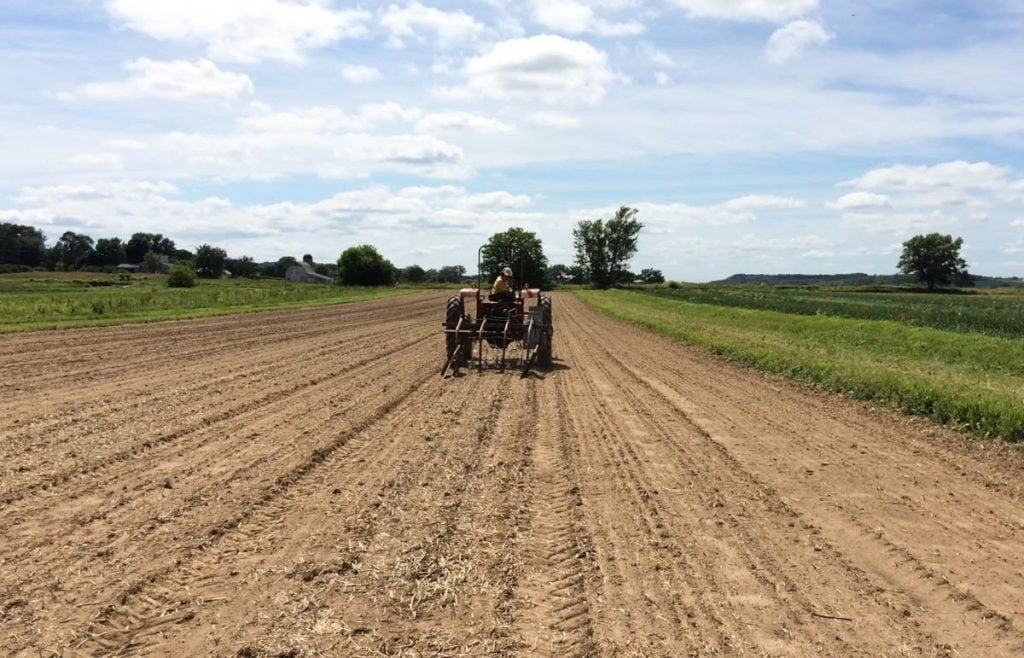
Steve flame-weeds a carrot field. Tiny weeds have emerged but the carrot seedlings are still safe underground. That’s the perfect time to flame.
Veggie list and veggie notes, July 21/22, 2016, week #10, purple EOW
There are a lot of ‘splits’ in this week’s box. See the last two lines of my list below. Tomatoes and eggplant are just getting started. Soon, the harvests will increase and we will be swimming in tomatoes, peppers and other summer crops. The melons are very, very close to ripening. Maybe next week? Maybe the following week? We decided to send two types of onions this week, to give you flexibility. We continue to send sweet Walla Walla onions but have added one big white onion so you also have an onion suitable for frying.
‘Caraflex’ cabbage, 1 medium or 2 small
Sweet corn, about 3 ears
Cucumbers, about 2
(a mix of #1 grade and #2 grade)
Green beans, 1.1 lb
Zucchini and summer squash, 3+ lb
Walla Walla onion, 1 or 2
White onion, 1 large
Green bell peppers, 2 medium
Basil, Italian, 1 husky sprig
Basil, Thai, 1 small bunch
Snap peas OR cherry tomatoes OR globe eggplant
An extra handful of beans OR 1-2 tomatoes OR Japanese eggplant OR a small kohlrabi OR an extra mini cabbage.
Next week’s box will probably contain sweet corn, snap peas, zucchini, cucumbers, onions, tomatoes, an herb and more.
‘Caraflex’ cabbage – This is the same type of cabbage that we sent three weeks ago. Tender, crunchy, they are great for cole slaw and summer salads.
Sweet corn – We have just a few ears this week, as the field gets going. Most are on the young side. Personally, that’s my favorite stage. More will be ready next week.
Cucumbers – We will pack a mix of #1 and #2 grade cucumbers. The #2 grade cucumbers have scarring from wind damage, or are small. The bees are less active in hot weather and don’t spend as much time pollinating and we end up with some smaller cukes.
White onion & Walla Walla onion – You can distinguish these onions by their color. White onions are white. Walla Wallas are white to yellowish, with loose outer skins. See photos. They have distinct uses. Wallas are sweet onions – great for salads, or grilled kebobs, or added to dishes near the end of cooking. White onions are much more pungent and will fry better than Wallas. Pan-fry the white onion with your peppers and zucchini and basil for an tasty combination. Let’s face it; these early onions will have some soil attached. We harvest them as fresh onions. The outer roots and skins don’t have time to dry for easy removal. A quick wipe will clean them up.
Storage: Both Wallas and white onions are best refrigerated at this time of year.
Basils – We will pack two types of basil this week. See photo. Thai Magic is the the same licorice-scented basil we sent last week. Eleonora is an Italian basil.
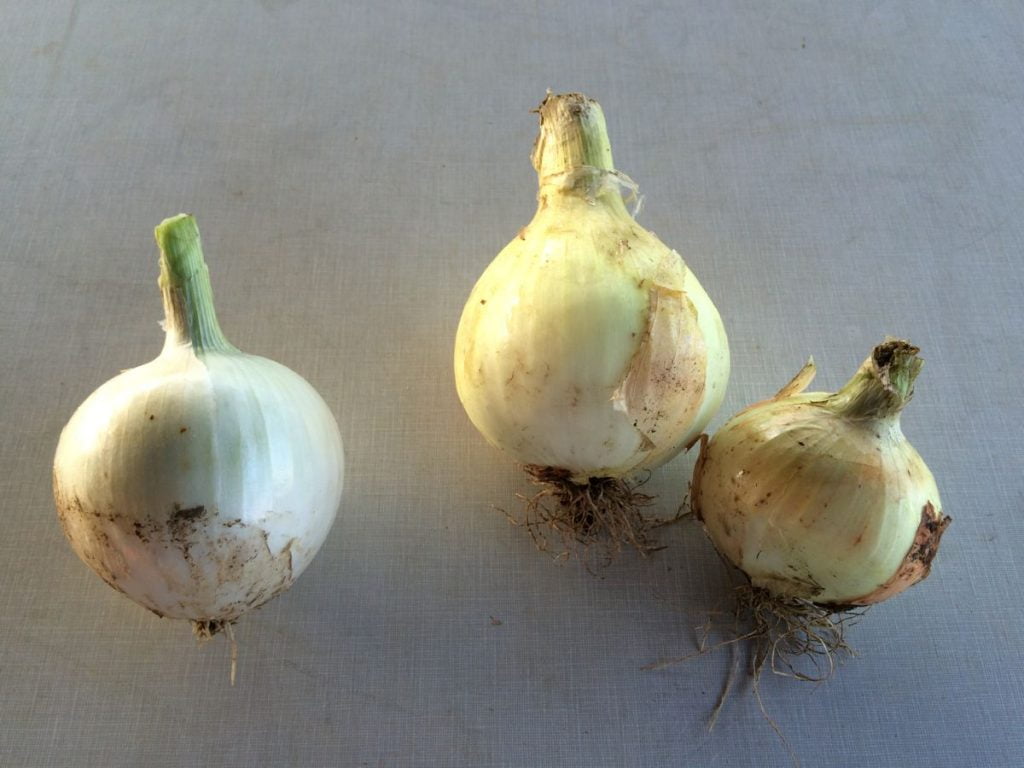
White onion (left) and two Walla Walla onions (right). Note the light yellow color and loose skins of the Wallas.
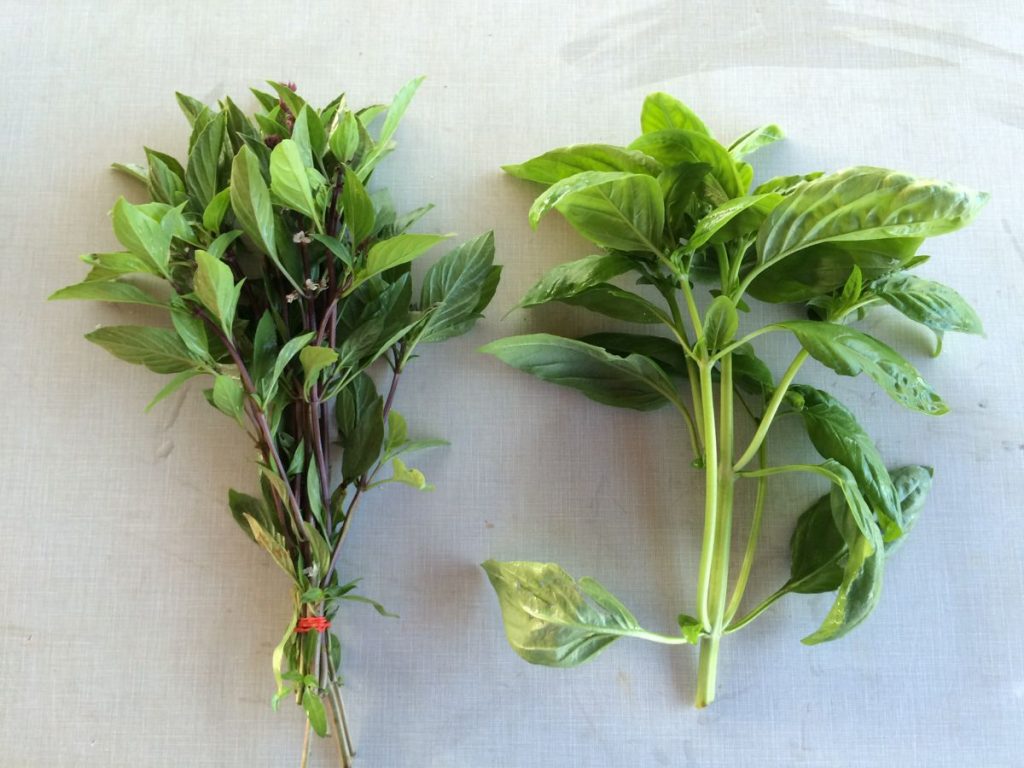
Thai Magic basil (left) and Italian basil (right). Both will be in the box this week.
RECIPES FROM LAUREN
SPICY CABBAGE & CORN COLESLAW
I had something like this at the Willy Street Co-op once and just couldn’t get the perfect combination of corn and cabbage out of my mind for months. This coleslaw is exactly what your summer table needs!
Takes 30 minutes
Serves 4-6
3 ears of corn, shucked
5 cups shredded green cabbage
1 white onion, diced
1/2 cup mayonnaise
1 tablespoon chili powder
2 teaspoons oregano
2 teaspoons cumin
1/4 teaspoon cayenne
2 limes, juiced
1 teaspoon spicy brown mustard
2 teaspoons honey
1 teaspoon kosher or sea salt
Fresh cracked black pepper, to taste
- Bring a large pot of salted water to boil. Fill a large bowl with ice water and set aside.
- Add corn to the boiling water. Boil for 1 minute. Drain, quickly rinse under cold water to stop the cooking process. Continue rinsing until corn feels cool to the touch.
- Using a knife, cut the corn off the cob. Learn a great technique here!
- In a large bowl combine the corn, cabbage, and onion.
- In a small bowl, whisk together the mayonnaise, chili powder, oregano, cumin, cayenne, lime juice, mustard, honey, salt, and pepper.
- Pour the dressing over the cabbage mixture and toss to coat. Chill and serve.
– – – – – – –
SUMMER SQUASH, ONION & BELL PEPPER PIZZA WITH ZUCCHINI CRUST
As usual, this recipe is very versatile. You could just make the zucchini pizza crust and top it with whatever you like (pizza sauce, pepperoni and mozzarella for example) or you can go totally vegetarian as I did and top it with CSA ingredients. I used pesto for the sauce because we always have pesto in our fridge in the summertime, but feel free to use any pizza sauce that you have on hand!
Takes 1 hour, 15 minutes
Serves 2-4
4 cups shredded zucchini (shredded with a cheese grater or food processor)
2 teaspoons Kosher salt, divided
1/3 cup all-purpose flour
1 cup Gouda cheese, divided
1/2 teaspoon garlic powder
1/2 teaspoon dried oregano
1/2 teaspoon dried basil
1 egg
2 tablespoons olive oil, divided
1 Walla Walla onion, thinly sliced
Freshly ground black pepper
1 green bell pepper, diced
1 summer squash, halved and sliced
1/3 cup prepared pesto, pizza sauce or other sauce of your choosing
8-10 Italian basil leaves
- Preheat oven to 525 degrees. Place baking stone, pizza pan or baking sheet you plan to bake pizza on in oven while it preheats. (Allow the pan to get really hot will help keep the pizza crust from sticking).
- Combine shredded zucchini and 1 teaspoon Kosher salt in medium bowl and let sit for 15 minutes. Wrap shredded zucchini in cheese cloth and squeeze until no water remains. This should take about 5 minutes as there is a lot of water in large zucchini. It’s important to get the majority of the water out to ensure a crispy (not soggy) crust! Combine the shredded zucchini, flour, 1/2 cup Gouda, garlic powder, oregano, basil and egg in a clean medium bowl. Stir ingredients together until mostly incorporated and then use your hands to make mixture smooth and even.
- Turn mixture out onto a piece of parchment paper. Press with your hands into a 10-inch circle about a 1/2-inch thick (or another shape if you don’t have a round baking pan). Remove baking stone, pizza pan or baking sheet from the oven and slide parchment (and crust) onto it. Place crust in oven and bake for 15 minutes until golden brown all over. Remove and let cool for 5 minutes.
- Meanwhile, prepare topping. Heat 1 tablespoon olive oil in a large skillet over medium heat. Add onion, 1/2 teaspoon Kosher salt and freshly ground black pepper. Reduce heat to medium low and cook for 10 minutes until well-softened and fragrant. Add remaining olive oil, bell pepper, summer squash, remaining Kosher salt and more freshly ground black pepper. Add a tablespoon water to the pan if things are sticking. Cook for additional 15 minutes. Set aside until ready to use.
- Once pizza crust has been allowed to cool, flip it so that golden brown side is down on the baking pan. Remove from parchment (use a spatula if it doesn’t come off easily). Top with sauce, followed by cooked veggies, then a handful of fresh basil leaves and remaining Gouda. Bake 10-15 minutes until pizza is cooked through and cheese is golden.
– – – – – – –
LOCAL THYME RECIPES
I asked Pat to prepare eggplant recipes, even though not everyone gets eggplant this week. It is an unfamiliar vegetable for some. Everyone will get eggplant in the coming weeks, so note any recipes you want to return to. Beth
Comforting Classics
Spicy Pan Fried Eggplant
Roasted Summer Squash with Crumbled Frico
Roasted Green Beans with Pecorino Romano
Warm Japanese Cabbage Salad
Outside the Box Recipes
Smoky Eggplant Chutney
Spiralized Zucchini “Noodles”
Green Beans and Cabbage with Coriander Butter
Cabbage Pie with Feta
Quick and Easy Meal
Cabbage, Zucchini and Pepper Fried Rice

whew
- On: July 13, 2016
 1
1
It was a big week for us. Lots of new crops, lots of irrigation, lots of heat. We hosted a farm tour on Monday for 60 – 70 farmers, aspiring farmers, students, grocery managers, ag professionals and even a few CSA members. We’re glad to share our farming experience. Some business owners hold their knowledge as trade secrets. Not us. In farming, knowing what to do is the first step. Raising crops well takes many, many more steps. Beth

It was a good day, with nice turnout, although incredibly hot. Almost everyone stuck around for the 3 hour tour, despite the heat. We walked the length of the farm, stopping at individual fields to talk about each crop. Photo credit, MOSES.

Steve explained the details of growing carrots for fall harvest. Seeded this time of year, so they need extra attention during hot, dry weather.

I talked about onion diseases and insects. Photo credit, MOSES

Alice in Dairyland (Ann O’Leary) attended! She has a special connection to our area, as a graduate of both the Evansville High School and Evansville 4H club. From left; Beth, Alice/Ann, Steve.
Veggie list and veggie notes (July 14/15, 2016, week #9, green EOW)
Carrots, 2 lb
Swiss chard, 1 bunch
Green beans, about 0.6 lb
Green bell peppers, 2
Walla Walla onion, 1 lg or 2 med
Zucchini & summer squash, 4+ lb
Cucumbers, 2
(One #1 grade, plus one or two #2 grade)
Thai basil, 1 husky sprig
Fresh garlic, 1 bulb or 2 small bulbs
Next week’s box will probably contain green beans, Caraflex cabbage, cucumber, zucchini/squash, onions and more.
Carrots – Here we go … the first summer carrots of the year.
Swiss chard (pretty bundle of green leaves) – Our crew did a nice job mixing colors for pretty bunches. Swiss chard is a close relative of spinach, but requires a bit more cooking. Use as a substitute in any recipe that calls for spinach, just cook the chard a little longer. Both stems and leaves are delicious. The stems requite longer cooking, so cut them free from the leaves when preparing. That allows you to cook the stems longer.
Green bell peppers – We have the first bell peppers for you. We harvested an early variety that tends to be medium or small. There are some oddball-looking ones, as expected this time of year.
Walla Walla onion – Yeah for the first Walla Wallas! These are sweet onions, crisp and very mild. Wonderful raw or lightly cooked. Do not try to fry these onions – it doesn’t work because of their high water content.
Zucchini and summer squash – We are sending a lot this week because the squash are at their peak production. Wow, they love hot weather.
‘Thai Magic’ basil – Great in Thai and Indonesian dishes, this Thai basil is a fine substitute for Italian basil. We really like this variety! The flavor is excellent, with a mild hint of anise, but no bitterness. The flavor is strong so try using half the amount you would add when using Italian basil. Taste and add more if you wish.
Fresh garlic – Here’s a treat. Harvested fresh this week and sent to you without drying, this garlic is super crunchy and tasty. The succulent skins peel off readily. Refrigerate.
RECIPES FROM LAUREN
Sesame Noodles with Cucumber
Adapted ever so slightly from Smitten Kitchen
Takes 30 minutes
Makes 4 generous servings
3/4 pound dry rice noodles (I love the flat ones often used in Pad Thai)
1 tablespoon smooth peanut butter
2 tablespoons tahini (more peanut butter is an acceptable substitution)
1/4 cup soy sauce
2 tablespoons rice vinegar
2 tablespoons toasted sesame oil
1 tablespoon granulated or brown sugar
2 teaspoons minced garlic (from 1 medium-large clove)
1 green bell pepper, seeded and minced
1 cucumber, very thinly sliced
1/2 cup roasted salted peanuts, roughly chopped
A handful of chopped fresh Thai basil
Sriracha or other garlic-chile paste to taste
1. Cook noodles according to package directions and rinse with cold water to stop the cooking process. Drain well. Set aside.
2. Meanwhile, whisk together peanut butter and tahini in the bottom of a small bowl until smooth, then add soy sauce, rice vinegar, sesame oil, sugar, garlic and green pepper. Stir until well-mixed. Adjust flavors to taste. It might seem a bit salty from the bowl, but should be just right when tossed with noodles.
3. Toss sauce with cold noodles in a large bowl.
4. Place a medium-sized knot of dressed noodles in each bowl, followed by a pile of cucumber. Garnish generously with peanuts and Thai basil. (When you serve, you are looking for a ratio of one: one in the noodles to crunchy delicious toppings department). Serve with Sriracha (or other garlic-chile paste) on the side.
– – – – – – –
Sweet Onion & Chard Quiche
Takes 1 hour, 20 minutes if using store bought crust (about an hour longer if not)
Serves 4-6.
1/2 batch of my Favorite Pie Dough, chilled(or store bought pie crust)
All-purpose flour (for surface)
1 large Walla Walla onion, cut in half and thinly sliced
2 tablespoons olive oil, divided
1 cup water
1 tablespoon balsamic vinegar
1 bunch chard, ribs removed, loosely chopped
2 tablespoons pure maple syrup
Kosher salt
Freshly ground black pepper
1 pound summer squash, halved and sliced
6 ounces sharp white cheddar cheese, grated (about 2 cups)
4 large eggs
3/4 cup creme fraiche (or sour cream)
3/4 cup heavy cream
- If preparing pie crust from scratch, preheat oven to 350 degrees and roll out chilled dough onto a well-floured surface. Transfer to a 9-inch pie pan and place in freezer for 15 minutes. Remove prepped crust from freezer, line with parchment or aluminum foil and fill with rice, dried beans or pie weights. Bake for 30 minutes until just beginning to brown.
- Meanwhile, prepare your filling. Heat one tablespoon olive oil in a large skillet over medium heat. Add onion and saute for 5 minutes until beginning to soften. Add water and balsamic. Bring to a boil, reduce to a simmer and cook for 10 minutes until the mixture has thickened considerably. Add chard and saute for 5 minutes until wilted. Add maple syrup along with salt and pepper to taste. Cook 5 minutes longer until liquid has turned a little syrupy. Remove mixture to a bowl (with any syrup) and wipe pan clean with a paper towel.
- Add remaining olive oil to pan. Add summer squash along with salt and pepper. Saute gently for 5 minutes until softened.
- Scatter cheese over the pre-baked pie crust. Top with summer squash followed by chard onion mixture, making sure to get any syrupy liquid into the quiche.
- In a medium bowl, whisk together eggs, crËme fraÓche and heavy cream. Season lightly with salt and pepper. Pour into quiche. Bake for 35-40 minutes until set and golden brown in spots.
– – – – – – –
LOCAL THYME RECIPES
Comforting Classics
SoCal Pickled Carrots for Tacos
Baked Orzo with Chard
Sesame Green Bean and Pepper Stir Fry
Farro Salad with Grilled Vegetables
Outside the Box Recipes
Pennies From Heaven
Pasta Salad with Creamy Goat Cheese and Romano Dressing
Green Beans with Wild Mushrooms
Chicken Breasts and Zucchini with Herbs
Quick and Easy Meal
July 7 2016
- On: July 09, 2016
 0
0
Veggie List and Veggie Notes (July 7/8, 2016, week #8, purple EOW)
Beets with greens, 1 bunch
Snow peas, 1/4 – 1/3 lb
Cucumbers, about 3
Green zucchini
Yellow summer OR patty pan squash
Total zucchini and squash = 3 – 3.5+ lb
Romaine OR green leaf lettuce
Lacinato OR Red Russian kale, 1 bunch
Scallions, 1 bunch
Basil, 1 – 4 sprigs, depending on size
Next week’s box will probably contain Swiss chard, zucchini and summer squash, cucumbers, Walla Walla onion, carrots(?), an herb and more.
Beets with greens – Beet greens are tasty. They are similar to Swiss chard in flavor, texture & cooking time (the two crops are very closely related.) You can remove the thickest midribs before cooking if you wish, but it is not essential.
Storage: Cover and refrigerate. Separate the tops and roots if you don’t plan to eat the greens immediately, to preserve freshness in the roots. Beet greens are perishable and should be eaten soon. The beet roots will last for weeks.
LOCAL THYME RECIPES

Comforting Classics
Beet and Beet Green Risotto with Walnuts and Blue Cheese
Sweet Zucchini Pickles
Skewered Scallops with Cucumbers and Basil
Cheesy Kale Linguini
Outside the Box Recipes
Raw Beet Salad with Mustard Seeds or Beet and Beet Green Spaghetti with Poppy Seeds
Grilled Shrimp and Zucchini Salad with Creamy Lemon Dressing
Cucumber Buttermilk Salad Dressing
Catalan Wilted Kale
Quick and Easy Meal

